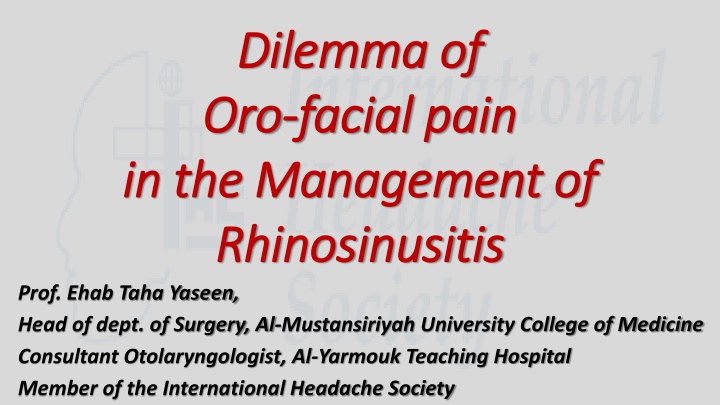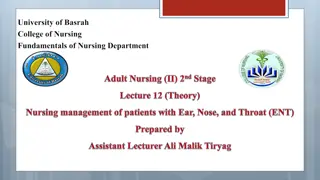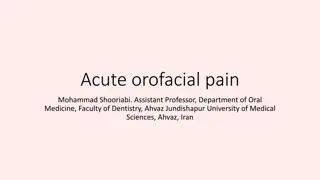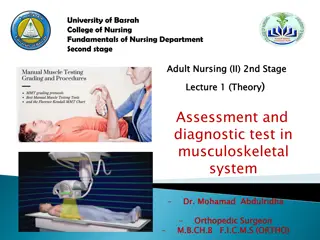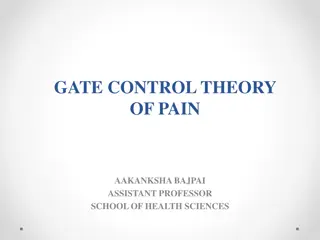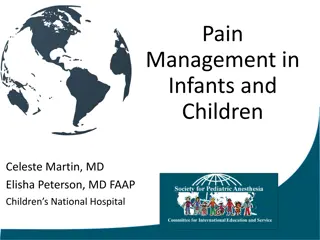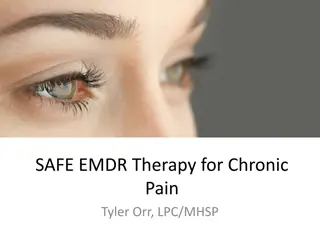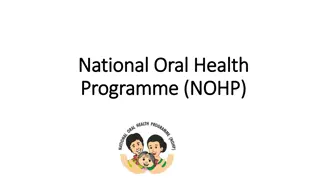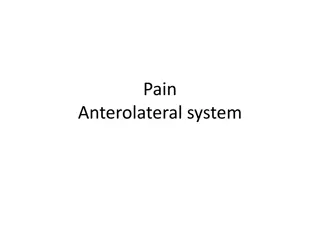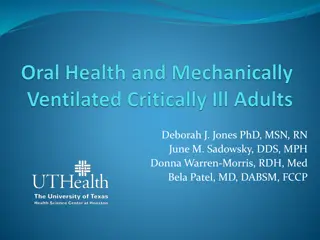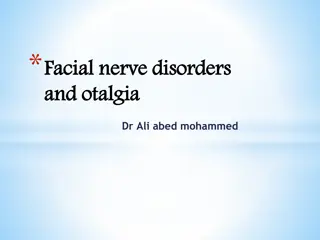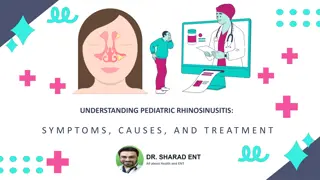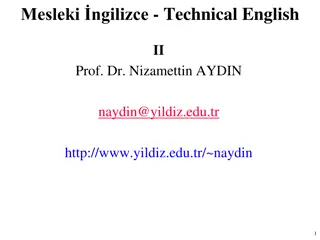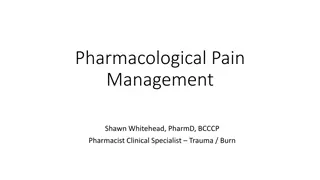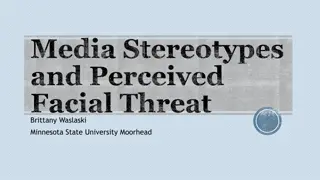Managing Rhinosinusitis-Oral-Facial Pain Dilemma
Otolaryngologist insights on diagnosing sinus-related facial pain, challenges in differentiation, prevailing misconceptions leading to misdiagnoses, and strategies to improve patient outcomes. Learn about the complexities of facial pain assessment and the importance of accurate diagnosis in rhinosinusitis management.
Download Presentation

Please find below an Image/Link to download the presentation.
The content on the website is provided AS IS for your information and personal use only. It may not be sold, licensed, or shared on other websites without obtaining consent from the author.If you encounter any issues during the download, it is possible that the publisher has removed the file from their server.
You are allowed to download the files provided on this website for personal or commercial use, subject to the condition that they are used lawfully. All files are the property of their respective owners.
The content on the website is provided AS IS for your information and personal use only. It may not be sold, licensed, or shared on other websites without obtaining consent from the author.
E N D
Presentation Transcript
Dilemma of Dilemma of Oro Oro- -facial pain facial pain in the Management of in the Management of Rhinosinusitis Rhinosinusitis Prof. Ehab Taha Yaseen, Head of dept. of Surgery, Al-Mustansiriyah University College of Medicine Consultant Otolaryngologist, Al-Yarmouk Teaching Hospital Member of the International Headache Society
The goals The goals The goals of this lecture are: - Not to increase the patients suffering The core of medicine is to preserve and restore patient s health and to minimize their suffering . - To improve awareness about the development of diagnostic criteria to enhance the accuracy and to management. ensure optimal rhinosinusitis - To reverse the idea that sinus surgery is usually failing .
Objectives Objectives Put your own management strategy. To elucidate why there is dilemma in the diagnosis of sinus related pain. Have a knowledge of the IHS* classification of headaches - (The treatment of face pain is strongly etiology driven) Remember well the criteria of sinus pain * IHS: International Headache Society
Agenda Agenda Strategy Causes of dilemma. Oro-Facial pain (OFP), definition, causes and differentiation. Description of sinus pain.
Strategy Strategy From the perspective of otolaryngologist the most important differentiation, perhaps, is between facial symptoms of sinogenic aetiology and those that are not.
Reaching the correct diagnosis in patients with facial pain is challenging, Reaching the correct diagnosis in patients with facial pain is challenging, Why? Why?(The reasons of dilemma) (The reasons of dilemma) The diagnosis of face pain is loaded by the prevailing opinions: 1. Pain is not uncommonly due to sinus problem (reported prevalence rate 5-15%) 2. That if the pain is stabbing or burning, it is neuropathic in origin, which is, however, by far not always the case. 3. Often face pain is thought to be caused by trigeminal neuralgia and treated accordingly, medically or surgically. However, the only reason the condition ranks high on the face-pain diagnostic list is because: It is generally the only face-pain etiology known to physicians
4. Migraines are commonly misdiagnosed as sinus headache in 40% of patients. 5. Many patients come with fixed ideas about the cause of their pain. 6. The majority are convinced they have sinusitis, a not unreasonable view because the diagnosis has often been confirmed by their general practitioner or other specialists. 7. A proportion of patients have already undergone unsuccessful nasal or sinus surgery.
8. Discriminating between the causes of pain is, perhaps, theoretically too difficult for the large majority of our patients. 9. Patients may present with severe and intractable headache with radiation, although patient history, physical examination, and laboratory data demonstrate no active disease. 10. It is also highly relevant that over 80% of patients with endoscopic evidence of purulent secretions have no pain. 11. Moreover, if surgery is performed in cases where facial pain is the dominant symptom without firm clinical evidence of rhinosinusitis, not surprisingly, a significant proportion of these patients continue to complain of facial pain post-operatively.
12. Endoscopic signs which may suggest sinus problem: - Polyposis - Outflow obstruction - Mucosal disease These signs are frequently subtle and may, therefore, be missed 13. Finding pathological changes on imaging of acute rhinosinusitis, correlating with the patient s pain description, is not enough to secure the diagnosis of Headache attributed to acute rhinosinusitis.
Pain Pain Definition Definition Task force on taxonomy of the International Association for the Study of Pain (IASP) says that pain is: An unpleasant sensory and emotional experience associated with actual or potential tissue damage, or described in terms of such damage
Definition Definition of of Orofacial Orofacial pain pain (OFB) (OFB) Is the presenting symptom of various spectrums of diseases These symptoms may be arises from: 1. Disease of orofacial origin 2. Musculoskeletal origin 3. Nervous system origin 4. Psychological abnormality 5. Referred from cervical muscles 6. Intracranial pathology. 7. May occur without known reason Might have normal physical, imaging, or laboratory findings. Some of the OFP disorders are easily diagnosed and treatable, but others are difficult to classify and unresponsive to routine methods of treatment.
Chronic orofacial pain: Duration for 3 months or longer. Reported by 7% of the people Female : Male = 2:1 Occurrence 10% in 36 to 44 years, 5% in 18 to 35 years and 64 to 75 years. In general, tend to decreased in its occurrence with age An interdisciplinary approach is often required to establish a correct management.
International Headache Society (IHS) classification and diagnostic criteria for International Headache Society (IHS) classification and diagnostic criteria for headache disorders, cranial neuralgia, and facial pain headache disorders, cranial neuralgia, and facial pain 1. Migraine (Migraine without aura and Migraine with aura) 2. Tension-type headache 3. Cluster headache and clinical paroxysmal hemicrania 4. Miscellaneous headaches unassociated with structural lesion 5. Headache associated with head trauma 6. Headache associated with vascular disorders 7. Headache associated with non-vascular intracranial disorder 8. Headache associated with substances or their withdrawal 9. Headache associated with non-cephalic infection 10. Headache associated with metabolic disorders 11. Headache or facial pain associated with disorder of cranium, neck, eyes, ears, nose, sinuses, teeth, mouth, or other facial or cranial structures 12. Cranial neuralgias, nerve trunk pain and deafferentation pain 13. Headache not classifiable
The AAOP has classified OFP disorder as based on IHS classification The AAOP has classified OFP disorder as based on IHS classification system system Intracranial pain disorders Neoplasm, aneurysm, abscess, hemorrhage, hematoma, edema Primary headache disorders (neurovascular disorders) Migraine, migraine variants, cluster headache, paroxysmal hemicrania, cranial arteritis, carotidynia, tension-type headache Neurogenic pain disorders Paroxysmal neuralgias (trigeminal, glossopharyngeal, nervus intermedius, superior laryngeal) Continuous pain disorders (deafferentation, neuritis, postherpetic neuralgia, post-traumatic, and postsurgical neuralgia) Sympathetically maintained pain Intraoral pain disorders Dental pulp, periodontium, mucogingival tissues, tongue Temporomandibular disorders Masticatory muscle, temporomandibular joint, associated structures Associated structures Ears, eyes, nose, paranasal sinuses, throat, lymph nodes, salivary glands, neck
Types of OFP Types of OFP 1. Stabbing neuropathic pain (Trigeminal neuralgia) 2. Stabbing nociceptive face pain 3. Continuous neuropathic face pain 4. Continuous nociceptive face pain A) Continuous peripheral nociceptive face pain B) Continuous central nociceptive face pain
Trigeminal Trigeminal neuralgia neuralgia The best known neuropathic face-pain condition, with stabbing, jabbing, or lancinating pain in the face as its very hallmark. Unilateral and limited to the innervations area of one of the branches of the trigeminal nerve, usually the maxillary nerve, although occasionally two adjacent branches are involved but rarely the ophthalmic nerve. Stabbing headache is also of migrainous origin (nociceptive) A diagnosis of neuropathic pain requires more than just a stabbing, jabbing, or lancinating temporal pattern but also symptoms or signs of nerve dysfunction, and the same applies to pain of a burning nature. The required symptoms or signs of nerve dysfunction concern the sensory response to fine touch in the painful area, consisting of paresthesia, dysesthesia, or allodynia, respectively referring to a tingling sensation, an unpleasant sensation, or pain.
Stabbing nociceptive face pain Stabbing nociceptive face pain It is also unilateral like trigeminal neuralgia but not limited to the innervation area of a particular branch of the trigeminal nerve. As it is not neuropathic in origin, it is not triggered by touch and neither is it associated by fine touch causing paresthesia (tingling), dysesthesia (unpleasant sensation, such as the touch of a finger being perceived as that of an ice pick), or allodynia (pain). Stabbing face pain of neuropathic origin requires imaging of the cerebellopontine angle and treatment with an anticonvulsant, while stabbing face pain of nociceptive nature is treated preventively with indomethacin
Continuous neuropathic face pain Continuous neuropathic face pain Neuropathic face pain, that is, pain in the face associated with the symptoms or signs of nerve dysfunction mentioned above, can also be non-stabbing in temporal pattern. Then it is generally continuously present, unilateral in location, and limited in its distribution to one of the divisions of the trigeminal nerve. It does not have to be burning in quality, as is often assumed to be the quality of neuropathic pain when not stabbing, and can be associated with superimposed stabbing pain. The condition is painful trigeminal neuropathy and requires, like trigeminal neuralgia, imaging of the cerebellopontine angle.
Continuous nociceptive face pain Continuous nociceptive face pain If not stabbing in temporal pattern or neuropathic in origin, face pain tends to be continuous although other paroxysmal patterns than stabbing are possible but they are rare. For example, there is a facial variant of migraine, with severe face pain occurring in attacks that last for a day or days, associated with nausea and sometimes also with vomiting. In further diagnosing continuous non-neuropathic face pain, location of the pain in the face needs to be considered in terms of bilateral versus unilateral and peripheral versus central. This generates the two- by-two table, providing the four diagnostic categories of masseter tension, masseter spasm, referred pain from the nose or teeth, and sinus vacuum. Table : Differential diagnosis of continuous non-neuropathic face pain. Peripheral Central Bilateral Masseter tension Sinus vacuum Unilateral Masseter spasm Referred from nose or teeth
Continuous peripheral nociceptive face pain Continuous peripheral nociceptive face pain Peripheral face pain, located peripherally in the face, that is, in the jaw(s), involves the muscles of mastication, particularly the masseter muscles in terms of masseter myalgia. When bilateral, it tends to generate a low-level intensity pain and when unilateral, a high-level intensity pain.
Continuous central nociceptive face pain Continuous central nociceptive face pain Pain located in the area of the nose and/or cheek, in the same way as peripheral face pain, tends to be of a low-level intensity when bilateral and of a high-level intensity when unilateral This drawing sensation centrally in the face is caused by under-pressure in the sinuses. It is the result of closure of the passages to the sinuses, particularly the nasofrontal ducts and ostiomeatal complexes. (congenital, inflammation,
Unilateral central face pain is located in the side of the nose and/or cheek : - Referred from a maxillary incisor - Hard intranasal contact Hard intranasal contact relates to a septal spur driving into a turbinate. Usually the inferior turbinate is involved, causing referred pain in the cheek, and sometimes the middle turbinate, causing referred pain in the side of the nose. The inferior turbinate may also cause referred pain in the maxillary teeth, again mistakenly suggesting a dental origin of the pain
Intranasal-contact pain may also be associated with localized autonomic symptoms of the ipsilateral eye and/or nostril, such as conjunctival injection, lacrimation, or rhinorrhea, often leading to the erroneous diagnosis of cluster headache, However, the typical temporal pattern of cluster headache is missing, that is, attacks that occur daily or almost daily, one to three times per 24 hours, and lasting for 1 or 2 hours. Sometimes, the intranasal contact can be seen on a brain magnetic resonance image (MRI) but the diagnostic test of choice is computerized tomography (CT scan) of the nose and sinuses with soft-tissue coronal views.
Enough evidence now exists to suggest that sinusitis per se does not cause pain but instead, may be associated with other more vague symptoms Patients may complain of pressure, fullness or throbbing in the distribution of the paranasal sinuses or at the vertex of the head. Symptoms may be bilateral or unilateral, particularly if individual sinuses are affected by pathology Exacerbation of these symptoms on bending forwards is not, however, diagnostic or suggestive of rhinosinusitis.
Why there is pain in sinusitis? Why there is pain in sinusitis? Several physiopathological theories have been postulated Convergence hypothesis due to rebound mechanism Activation of the trigemino-vascular system Creation of a pressure differential Presence of inflammation Bacterial toxins Underlying osteitis
Headache attributed to acute rhinosinusitis Headache attributed to acute rhinosinusitis Diagnostic criteria: A. Any headache fulfilling criterion C B. Clinical, nasal endoscopic and/or imaging evidence of acute rhinosinusitis C. Evidence of causation demonstrated by at least two of the following 4 points: 1.Headache has developed in temporal relation to the onset of rhinosinusitis 2.Either or both of the following: a) Headache has significantly worsened in parallel with worsening of the rhinosinusitis b) Headache has significantly improved or resolved in parallel with improvement in or resolution of the rhinosinusitis 3.Headache is exacerbated by pressure applied over the paranasal sinuses 4.In the case of a unilateral rhinosinusitis, headache is localized and ipsilateral to it D. Not better accounted for by another ICHD-3* diagnosis. * ICHD-3= International Classification of Headache Disorders 3rdEdition
Note: 1. Migraine and 2. Tension-type headache are DDx - Similarity in location of the headache - Accompanying nasal autonomic symptoms in migraine Hence, the presence or absence of purulent nasal discharge and/or other features diagnostic of acute rhinosinusitis help to differentiate these conditions. Comments: Pain due to pathology in the nasal mucosa or related structures is usually perceived as frontal or facial, but may be referred more posteriorly. Finding pathological changes on imaging of acute rhinosinusitis, correlating with the patient s pain description, is not enough to secure the diagnosis of Headache attributed to acute rhinosinusitis. Treatment response to local anaesthesia is compelling evidence, but may also not be pathognomonic. An episode of Migraine may be triggered or exacerbated by nasal or sinus pathology.
Headache attributed to chronic or recurring rhinosinusitis Headache attributed to chronic or recurring rhinosinusitis Diagnostic criteria: A. Any headache fulfilling criterion C B. Clinical, nasal endoscopic and/or imaging evidence of current or past infection or other inflammatory process within the paranasal sinuses C. Evidence of causation demonstrated by at least two of the following: 1.Headache has developed in temporal relation to the onset of chronic rhinosinusitis 2.Headache waxes and wanes in parallel with the degree of sinus congestion and other symptoms of the chronic rhinosinusitis 3.Headache is exacerbated by pressure applied over the paranasal sinuses 4.In the case of a unilateral rhinosinusitis, headache is localized and ipsilateral to it D. Not better accounted for by another ICHD-3 diagnosis.
Comment: It has been questioned whether chronic sinus pathology can produce persistent headache. Recent studies seem to support such causation. However, pathological changes seen on imaging or endoscopy correlating with the patient s pain description are not on their own enough to secure the diagnosis of Headache attributed to chronic or recurring rhinosinusitis.
International Headache Society Diagnostic Criteria for Headache Attributed to Rhinosinusitis Category Criterion A Frontal headache accompanied by pain in 1 or more regions of the face, ears, or teeth and fulfilling criteria C and D B Clinical* , nasal endoscopic, computed tomography, and/or magnetic resonance imaging and/or laboratory evidence of acute or acute-on-chronic rhinosinusitis C Headache and facial pain develop simultaneously with onset of acute exacerbation of rhinosinusitis D Headache and/or facial pain resolves within 7 days after remission or successful treatment of acute or acute-on-chronic rhinosinusitis *Clinical evidence may include purulence in the nasal cavity, nasal obstruction, hyposmia, anosmia, and/or fever
Advice and Advice and Home Messages Home Messages The European position paper on rhinosinusitis and nasal polyps (EPOS) has now defined rhinosinusitis as a diagnosis made on clinical grounds based on the presence of characteristic symptoms, combined with objective evidence of mucosal inflammation A sensible evaluation with strict wise orientation before surgical management is the essential for an accurate diagnosis Management of rhinosinusitis is initially medical, with imaging reserved for failed maximal medical therapy, complications of rhinosinusitis, or suspicion of malignancy. Surgery should be targeted, as good correlation between symptoms, signs and radiological findings The establishment of Craniofacial pain centers with team work is crucial in the diagnosis of facial pain. Visit this website: https://www.ihs-headache.org/ichd-guidelines
References - Egilius LH Spierings. Diagnosis and Treatment of Face Pain: A Brief Guide. Open Access J Neurol Neurosurg. 2018; 7(5): http://dx.doi.org/10.19080/OAJNN.2018.07.555724 - Kumar KH, Elavarasi P. Definition of pain and classification of pain disorders. J Adv Clin Res Insights 2016;3:87-90. - Moustafa S.H. and Mohammed A. G. Role of some anatomical nasal abnormalities in rhinogenic headache. Egyptian Journal of Ear, Nose, Throat and Allied Sciences http://dx.doi.org/10.1016/j.ejenta.2012.01.006 - https://www.ihs-headache.org/ichd-guidelines - Scott-Brown s Otolaryngology and Head and Neck Surgery 2018 - E. DE CORSO1, M. KAR2, E. CANTONE3, D. LUCIDI1, S. SETTIMI1, D. MELE1, A. SALVATI1, N. BAYAR MULUK4, G. PALUDETTI1, C. CINGI5, Facial pain: sinus or not? Acta Otorhinolaryngol Ital 2018;38:485-496. https://doi.org/10.14639/0392-100X-1721
